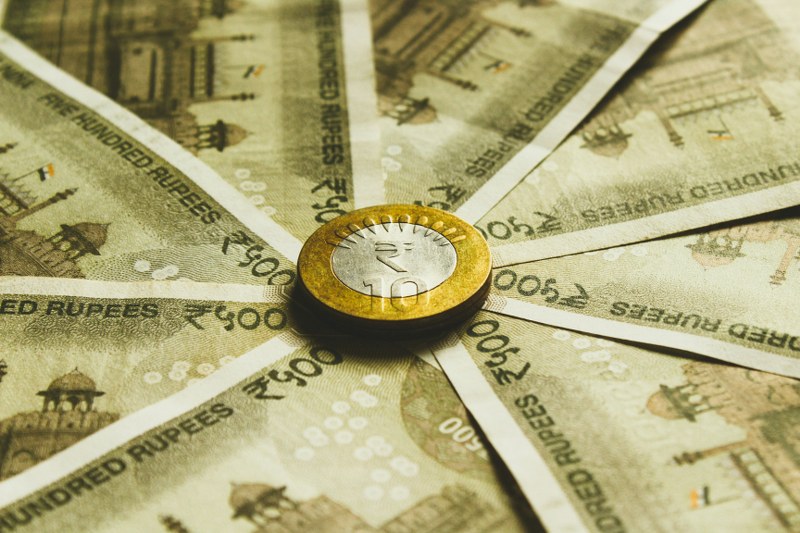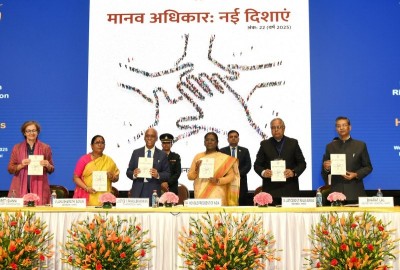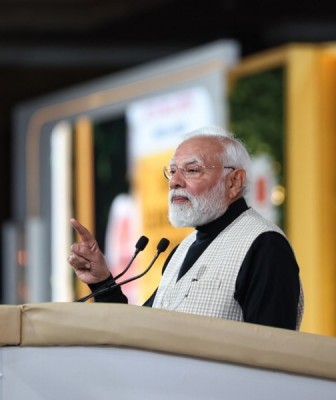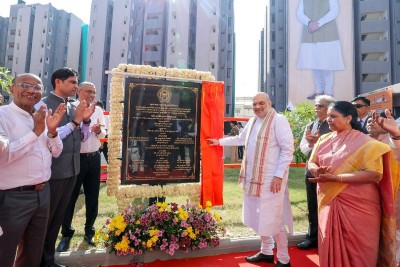 Indian Economy
Indian Economy
India's economic soar: A decade of unparalleled growth beyond expectations
India's economy is surging ahead of the pack, according to Krishnamurthy Subramanian, the Executive Director of the International Monetary Fund (IMF).
India is easily the world's fastest-growing major economy. India continues to be the world's top performer in economic growth, clocking in an 8.4% expansion in the final quarter of 2023, the BBC reported.
This strong growth is fuelled by a rise in consumer spending and positive performance in manufacturing and construction.
Moody's has revised India's GDP growth projection for 2024 to 6.8%, up from the earlier estimate of 6.1%.
The adjustment reflects India's robust economic performance in 2023 and a reduction in global economic challenges.
Surpassing analysts' expectations of 6.6%, India's economy accentuates the nation's resilience amid global economic challenges.
The International Monetary Fund (IMF) projections anticipate India's economy growing by 6.5% in 2024, compared with 4.6% for China.
This news arrives as India prepares for a general election this year.
Prime Minister Narendra Modi celebrated the figures on social media platform X (formerly Twitter), highlighting the Indian economy's resilience and potential. India's impressive growth, driven by strong manufacturing figures and healthy consumer spending, positions the country to surpass Japan and Germany as the world's third-largest economy in the coming years.
Similarly, a new report by NITI Aayog in India shows a significant reduction in multidimensional poverty. Over 248 million people (24.82 crore) escaped poverty in the last nine years (2013-14 to 2022-23).
This achievement is attributed to government initiatives addressing various aspects of poverty. The Multidimensional Poverty Index (MPI) used in the report considers factors beyond income, providing a more comprehensive picture.
India's MPI score dropped from 29.17% to 11.28%, with states like Uttar Pradesh, Bihar, Madhya Pradesh, and Rajasthan witnessing the biggest improvements. The report also highlights an accelerated decline in poverty between 2015-16 and 2019-21 compared to the previous decade.
Over the past nine years, India has seen a significant decrease in multidimensional poverty, with over 248 million individuals escaping its grasp. This progress is likely to see India achieve its goal of halving multidimensional poverty well before the 2030 deadline, thanks to several crucial initiatives across various aspects of poverty.
According to a recent commentary published by the Brookings Institute on the recently released official consumption expenditure data for 2022-23, India has achieved real per capita consumption growth of 2.9% per annum (pa) since 2011-12.
The share of rural growth (3.1% pa) is significantly higher than urban growth (2.6%).
India saw a remarkable drop in inequality across both cities and villages.
The Gini coefficient, a way to measure inequality, went down significantly in both areas. In cities, the Gini coefficient (on a scale of 100) fell from 36.7 to 31.9, and in rural areas it went from 28.7 to 27.0. This improvement is unprecedented, especially considering that India's economic growth has also been strong.
India's economic growth coupled with a significant reduction in wealth inequality has led to a near-elimination of extreme poverty, defined as living on less than $1.90 (PPP) per day.
This is reflected in the Headcount Poverty Ratio (HCR), which has dropped from 12.2% in 2011-12 to just 2% in 2022-23, representing a decrease of nearly 1 percentage point annually. While rural areas still have a slightly higher poverty rate (2.5%), it's encouraging to see urban poverty even lower at 1%.
It is no wonder that rural areas are seeing faster growth in spending.
The government has been putting a lot of effort into spreading wealth through various public initiatives.
This includes building toilets nationwide, making sure everyone has electricity, clean cooking fuel, and most recently, piped water access. For instance, in India, only 16.8% of rural areas had piped water on August 15th, 2019, but that number has jumped to 74.7% today.
 Image courtesy Pixabay
Image courtesy Pixabay
Having clean water likely means people get sick less, allowing families to earn more. Additionally, the Aspirational District Program identified 112 of India's most underdeveloped districts and targeted them with specific government policies to improve their development.
Initiatives like "Poshan Abhiyan" and "Anemia Mukt Bharat" have improved access to healthcare, leading to a notable reduction in deprivation. Additionally, the world's largest food security program, the Targeted Public Distribution System, ensures food grains reach over 813 million beneficiaries, demonstrating the government's commitment to tackling hunger.
This commitment is further solidified by recent decisions like extending free food grain distribution under the "Pradhan MantriGaribKalyan Anna Yojana."
Beyond food security, other programs like "UjjwalaYojana" for clean cooking fuel, "Saubhagya" for improved electricity access, and "Swachh Bharat Mission" and "Jal Jeevan Mission" for sanitation and water supply, have collectively improved living conditions and well-being.
Financial inclusion and housing needs are also being addressed through programs like "Pradhan Mantri Jan DhanYojana" and "PM AwasYojana."
A recent report by Barclays Research suggests that India has the potential to significantly increase its economic growth rate, and surpass China as the largest global growth contributor by 2023. To achieve this, the report emphasizes the importance of boosting domestic savings.
The report argues that several factors can contribute to a higher savings rate in India, including rising per capita income, demographic changes, and fiscal consolidation. These factors, combined, could potentially increase savings by 4% of GDP by the end of the decade.
This increase in domestic savings would be sufficient to finance the country's investment needs without relying heavily on external funding. Furthermore, with a higher savings rate and the government's plan to reduce the budget deficit, India may not need to implement further significant fiscal consolidation measures. This would help maintain macro stability even amidst faster economic growth along with potentially achieving a current account balance.
Prime Minister Narendra Modi highlighted the strength and potential of the Indian economy based on the robust 8.4% GDP growth witnessed in the third quarter of the current financial year (2023-24).
This impressive growth comes after two previous quarters with significant expansion (7.8% and 7.6%) and solidifies India's position as the fastest-growing major economy globally.
The data released by the Ministry of Statistics and Program Implementation depicts not only the high real GDP growth of 7.6% for the entire year 2023-24 but also the even higher nominal GDP growth of 9.1%. The consistent growth observed over the past three years (above 7% each year) demonstrates the strength of domestic demand driven by private consumption and investments. The government credits these positive developments to the various reforms and measures implemented over the past decade.
The International Monetary Fund (IMF) previously predicted strong growth for India.
They estimated the economy would grow at an average of 6.3% per year between 2023 and 2028, nearly doubling in size from $3.7 trillion to $5.9 trillion. This growth is expected to be accompanied by a rise in average income per person (per capita GDP) from $2,612 to $3,985.
In contrast, China's economy is projected to slow down significantly.
The IMF expects China's growth to average only 4% per year during this period. This slowdown is reflected in Moody's recent downgrade of China's credit rating. With a slowing China, the role of the main driver of growth in Asia is up for grabs. S&P has projected that India will be the fastest-growing economy in Asia between 2024 and 2026.
India commands the global economic stage with unparalleled growth, marked by an astounding 8.4% expansion in Q4 2023, securing its status as the world's fastest-growing major economy. The IMF projects a 6.5% growth in 2024, outshining China.
The remarkable reduction in multidimensional poverty, a drop in wealth inequality, and a near-elimination of extreme poverty showcase a holistic transformation.
Initiatives spanning healthcare, infrastructure, and poverty eradication highlight India's commitment to inclusive progress. Barclays Research envisions India surpassing China as a global growth leader by 2023, validating a decade of transformative reforms and steadfast economic fortitude. This outlook underscores the nation's remarkable journey toward economic preeminence and sustained prosperity.
(Dr Divya Rani is an Assistant Professor in the Department of Political Science, BHU, Varanasi. She contributes articles on issues of utmost importance.)
Support Our Journalism
We cannot do without you.. your contribution supports unbiased journalism
IBNS is not driven by any ism- not wokeism, not racism, not skewed secularism, not hyper right-wing or left liberal ideals, nor by any hardline religious beliefs or hyper nationalism. We want to serve you good old objective news, as they are. We do not judge or preach. We let people decide for themselves. We only try to present factual and well-sourced news.







